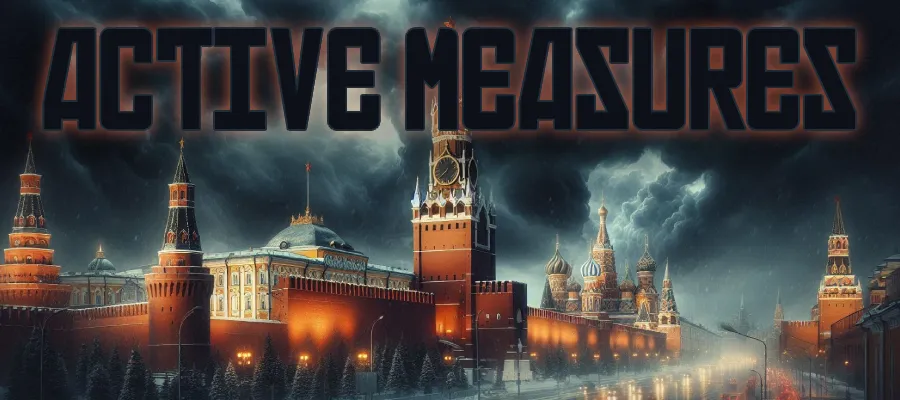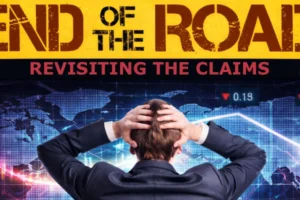The History and Status of Active Measures
Throughout history, nations have employed various strategies to manipulate perceptions, sow discord, and shape the ideological landscape of adversaries. The United States is not immune. This is evidenced by the immense division we have experienced in recent years. Of course, the word “psyop” has been of particular interest to Americans, with the volume of monthly searches ranging anywhere from 10K to 100K. It seems that people are starting to become curious about the various ways they are being manipulated. Interestingly, the term “Active Measures” barely hits the radar. They’re being distracted.
Many of these searches seem to center on China. Indeed, China has been in the news a lot for its efforts, but it’s not just the Chinese you need to be aware of. That’s because among the most effective and enduring of these strategies is what the Soviet KGB termed “Active Measures“—a broad set of covert tactics designed to influence public opinion, discredit opponents, and advance geopolitical objectives. Though its origins lie in the Cold War, Active Measures have not disappeared; rather, they have evolved, becoming more sophisticated in the digital age. Today, these tactics are an ongoing threat that exploits ideological divisions, media structures, and political discourse to destabilize nations from within.
The Historical Foundations of Active Measures
The Soviet Union developed Active Measures as a means of asymmetrical warfare against the West. Rather than relying solely on military might, the KGB sought to weaken the United States and its allies by manipulating their social and political environments. It worked, probably better than anyone had hoped. These efforts included disinformation campaigns, propaganda, forgeries, and the infiltration of political movements (read this sentence again).
One of the most well-documented examples was the Soviet attempt to spread false narratives about the U.S. government, such as the claim that the American military created HIV/AIDS as a bioweapon—an operation known as Operation INFEKTION. This fabrication, strategically planted in sympathetic media outlets and academic circles (think deeply about that), eventually gained traction and contributed to global anti-American sentiment. Indeed, I could share several examples, but the ones I don’t know about are probably the ones we should be concerned with.
Of course, the KGB also engaged in political influence operations, supporting Western politicians and activists whose agendas aligned with Soviet interests. Through a combination of financial support, media amplification, and direct engagement with ideological groups, they methodically worked to divide and distract. Sure, I’m trying to give you some history on the topic, but in reality, it’s not history at all. It’s happening now! These tactics merely laid the foundation for modern iterations of Active Measures, which have adapted and strengthened.
Modern Active Measures: A Digital Evolution
First, let’s remember that Putin is former KGB. Indeed, the Soviet Union may have collapsed, but the techniques of Active Measures have not disappeared; they were inherited by its successor agencies, particularly Russia’s Federal Security Service (FSB) and Main Intelligence Directorate (GRU). At the same time, we must remember that the modern propaganda battlefield is not just print media and radio but social media platforms, news aggregators, and cyber warfare.
Today, foreign actors use bot networks, cyberattacks, and targeted disinformation campaigns to shape public perception. Fake news sites, troll farms, and sympathetic social media influencers work in tandem to amplify divisive content, ensuring that misinformation reaches millions within hours, while simultaneously ensuring that solid content gets drowned out by the noise. Recent examples include the 2016 U.S. election interference, where Russian operatives weaponized Facebook and Twitter to manipulate voter sentiment. Of course, the spread of COVID-19 misinformation (on both sides) mirrored Soviet-style propaganda, but it’s unclear how much they had to do with that. Not that it matters, we know for a fact that the polarization of recent social movements has been exacerbated by foreign-backed actors infiltrating both right- and left-wing groups to deepen ideological rifts. The fact that COVID-Tribalism manifested the way it did gives us plenty of clues.
The Connection to Ideological Subversion
Active Measures are closely tied to what KGB defector Yuri Bezmenov described as “Ideological Subversion.” I posted a video of this on Rumble. Ideological Subversion involves gradually altering a nation’s ideological fabric to the point where it cannot recognize or resist foreign influence. Bezmenov outlined four stages of this subversion: demoralization, destabilization, crisis, and normalization. Each stage incrementally weakens national unity and social cohesion, making the country more susceptible to foreign manipulation.
Demoralization occurs when cultural, moral, and educational values are undermined, creating widespread distrust in institutions. Destabilization follows by exacerbating political and economic crises and weakening governance. A crisis is then manufactured, often through social unrest or manipulated events, leading to radical policy shifts or even governmental collapse. Finally, normalization cements the new status quo in a way that benefits the subverting power.
Understand that Ideological subversion is a subset of Active Measures, which is an umbrella category of Russian political warfare. However, this should tell you that there are plenty of other areas and tactics to consider. These tactics create a climate where Active Measures can operate more effectively, using planted narratives, compromised media outlets, and ideological activists to further their objectives. It’s not good. But if it is political warfare, wouldn’t the government be the target?
Who Are the REAL Targets?
Active Measures are primarily aimed at societies with open information systems and democratic governance, but especially Britain and the United States. However, it’s important to understand that while the stated goal of these operations may be to destabilize governments, the real target is the general public. That’s because public perception—more than any institution—ultimately shapes policy, elections, and national direction. As I’ve written and spoken about extensively, disinformation campaigns are designed not merely to mislead but to erode trust in government, amplify political polarization, and cultivate widespread cynicism. It’s a psychological war of attrition. Just as so-called “free” social media platforms profit by monetizing your attention, Active Measures attacks the government by manipulating and compromising the minds of the people. Make no mistake: in both scenarios, you are the target.
Sure, politicians and public figures can also be manipulated, sometimes unwittingly, into echoing talking points that align with foreign interests. But sometimes, they are absolutely complicit. Of course, the media, both traditional and digital, is an essential target as well, as journalists and news organizations amplify misleading narratives and nonsense while shutting down certain stories that hurt the cause. Ever wonder why or how the exact same divisive messaging (verbatim) seems to be shared by so many different people and organizations at the exact same time? Ever wonder why those politicians who collude and amass great wealth from China and Russia are not typically exposed in the media?
The scary part for me is that academia and think tanks responsible for shaping public policy and intellectual discourse are also vulnerable to this type of influence. Nonprofits are always looking for donations. Quid pro quo comes to mind here. Meanwhile, schools are always money-hungry, which makes them easy targets as well. After all, the Chinese have repeatedly demonstrated how easy it is to pretty much take over a school and teach communist ideals to children. Just hand over the money and walk on in. General funding and academic partnerships are great examples here.
On a similar note, we could talk about the ideological shift within educational institutions, where increasingly divisive narratives are being actively promoted. One can note when that started. That is telling in and of itself, but I want you to understand that the imbalance began when constitutional thinkers and principled voices gradually withdrew from academia, leaving the field wide open to those with unconstitutional perspectives and priorities. This retreat, though perhaps understandable, was a self-inflicted wound, one that has allowed the current dynamics to take hold largely unopposed. But again, why were constitutional thinkers and principled voices encouraged to leave in the first place? Where did that pressure come from?
Why Do Americans Follow Along?
Why or how would Americans knowingly or unknowingly participate in these efforts? A lot of it is ignorance, but I would argue that emotionally driven ideological alignment is a major factor. These are the sympathizers. Motivated reasoning might explain the rest, as individuals and organizations with grievances against their own government or society may agree with narratives planted by foreign adversaries. This alignment can lead them to embrace, amplify, and even defend disinformation as if it were their own conviction.
And while sympathetic ideology might be a large factor, we also have to think about how Americans could become susceptible in the first place. For this, I think we should look at a Chinese tactic for greater insight. China frequently engages in something known as “Elite Capture,” which is all about influencing politicians, business leaders, and academics in foreign nations. All they have to do is get someone with some influence on their side, and they can do some major damage.
Think about what happens when influential figures—teachers, executives, politicians—promote biased narratives. Because of authority bias, their claims are often accepted without meaningful scrutiny, especially by those who trust their credentials or charisma. This initial trust forms the groundwork for anchoring bias, where the information they received becomes the reference point for future judgment. Once that anchor is in place, subsequent information is interpreted through a filtered lens—one that resists contradiction. Over time, this feedback loop solidifies into Epistemic Rigidity. At that point, individuals aren’t just misinformed—they’re psychologically locked into a framework that actively resists correction.
When used as a weapon against the United States, you get Active Measures. Of course, we could probably discuss Reflexive Control at this point, as well, but this will likely be my next article. Regardless of the path, the result is the same: a hardened worldview, immune to evidence, and reinforced by a system that rewards conformity and punishes deviation. My next question to you is, does this sound familiar?
True, some may arrive there through ideological zeal, but for others, it’s financial incentives or career advancement. This is to say that financial incentives play another significant role. Even if they are not taking the money directly from foreign actors (which does happen), politicians, activists, and media outlets still benefit from the controversy, which increases viewership, donations, and influence. Factor in algorithmic amplification or engagement-based optimization that distorts perception and rewards extremism, and you have yourself a pretty big problem. At the same time, foreign entities with vast resources can discreetly fund think tanks, media operations, and political campaigns, ensuring that certain narratives receive disproportionate attention that only feeds algorithmic extremism.
Of course, the truth is that many individuals don’t even realize they are part of a larger influence operation. They truly believe that when they are getting on their social media and hitting that “share” button, or when they attend that rally, they are advocating for genuine causes rather than serving the interests of a foreign power. And since critical thinking is no longer taught, they have little hope of ever discovering the truth. In fact, because of Epistemic Rigidity, even if they eventually stumbled upon the truth, they would likely resist or deny it anyway. Unfortunately, this happens more than anyone would like to admit.
Of course, I think it’s important to recognize that social and psychological factors play a significant role in shaping our susceptibility to division as well. I think history will mark this era by manufactured political polarization and widespread unhealthy behaviors, ranging from poor nutrition and sedentary lifestyles to the pervasive influence of social media and declining educational standards. It is truly the worst kind of “perfect storm.” It’s like a horrible Classical Conditioning experiment, and it is truly sad.
Seriously! Just think about how education is now often seen as a burden, and ignorance is sometimes even celebrated. Remember that the ignorant are easily led. This combination is deeply troubling and far more dangerous than many are willing to acknowledge. But how did we become so divided, so quickly? How did we go from a worldwide powerhouse to a worldwide laughing stock? Some might argue that it is government corruption. Solid argument, but if so, how did that corruption take hold, and who stands to benefit? These are difficult questions, and often, the most revealing answers elude us simply because we hesitate to even ask them.
Either way, many Americans have developed an “us versus them” mentality with their neighbors, making them more willing to accept divisive rhetoric without scrutinizing its origins. Confirmation bias ensures that individuals seek out information that aligns with their preexisting beliefs, regardless of its veracity. The rapid spread of information on social media creates an environment where people share emotionally charged content without verifying its accuracy, further amplifying disinformation efforts. And if you want to know why so many scholars are pondering our collapse, this is some insight into why.
The Sympathizers
Russia thrives on chaos, supporting contradictory ideological movements to maximize division. Hence, they often play both sides of the field. Understand that one of the most effective tools in modern influence operations is the use of sympathetic social media influencers—individuals who, knowingly or unknowingly, amplify the narratives of foreign powers. But what exactly are they “sympathetic” to?
Let’s dissect this a bit. Russia’s overarching goal is to delegitimize government institutions and create an environment of confusion and polarization. As discussed in previous posts, this is dangerous because it leaves societies confused, ignorant, divided, and in a perpetual state of vulnerability. This vulnerability fosters reactive thinking, which ultimately keeps us from moving forward in any meaningful way. Of course, the question some might ask is, “If Russia (and China) are successful in eroding trust in government, what alternative would they prefer the United States adopt?“
I can envision a couple of options, but I highly doubt they care so long as their power and influence grow. That said, if U.S. institutions become deeply entangled with financial and corporate interests, mirroring Russia’s oligarchic system, it would only further weaken the country’s ability to stand up to Russian influence. This is to say that an elite-driven system that prioritizes wealth and power over democratic accountability would make the U.S. even more susceptible to Russian or Chinese manipulation than we already are. And while this is already our reality, in many ways, we must appreciate that it could get much worse.
What many of my readers are not going to like is that Russia (and China) benefit from a U.S. that turns inward and disengages from international leadership. In other words, a weakened, inward-looking America allows Russia to expand its influence with fewer obstacles. And this is an initiative that is seemingly underway. Don’t get me wrong. I am not saying that we need to be in NATO, nor am I saying that we should be the world police, but it’s not either-or. We definitely shouldn’t shut our door and pretend we don’t hear the commotion going on outside, because we are already in it.
That’s the scary part. Without some deep thought, it is really easy to buy into some of these positions. Sympathetic influencers, sharing ideas that “sound about right,” merely amplify narratives in a way that makes them sound like great ideas, which really just confuses the situation and makes getting real information distributed exceptionally difficult. But why would they do that? Well, it depends on which side of the fence they are playing on.
The truth is that Russia frequently supports influencers—both on the political right and left—who push anti-establishment narratives. Think about that. The Left is now generally “anti-right government,” and the Right is now generally “anti-left government.” So, Russia (and China) can simply push both sides and win because their bigger goal is to weaken and divide Western governance. The split is playing right into their hands. It’s a big game, and you’re the pawn. I’ll prove it to you.
Example:
P1: A significant number of traditionalists and conservative advocates oppose what they see as Western moral decay. As a result, they emphasize nationalism, religious identity, and the defense of traditional values. This includes resistance to progressive social policies, skepticism toward global institutions, and concern over what they view as the erosion of cultural norms, gender roles, and family structures.
P2: Many progressives take a critical stance toward American capitalism, viewing it as a system that perpetuates inequality and corporate exploitation. They often support Marxist feminism, advocate for expansive immigration policies, and promote social justice initiatives as corrective measures to historical and systemic injustice. In foreign policy, they tend to oppose U.S. military intervention and view alliances like NATO as extensions of imperialism, with some regarding adversarial states as necessary counterweights to Western dominance.
Now, there is a really good chance that you felt a certain way or even agreed with at least one of those paragraphs, while also feeling another way or disagreeing with the other one. That’s the point–they are both cognitive exploits. Russia doesn’t need you to support Russia. They just need you to oppose each other. Messaging that aligns with either side becomes useful as long as it leads to internal distrust, institutional paralysis, or social fragmentation. That’s the strategy—and it works, because it’s easy to get buy-in from a divided public.
The key here is toxic tribalism. If you remove the emotion for a moment, you will notice that each of the listings that I provided exacerbates the “Us versus Them” mindset, which creates something known as the “False Dilemma.” For clarity, each of those messages ignores or rejects a very important third option: American exceptionalism, cohesion, and Constitutionalism, which, in many ways, really solves the issues related to both P1 and P2. At the same time, if you think about it, you can note how that third (and ideal) option is largely omitted from American discourse in recent decades.
The point is this: we all lose when we allow ourselves to be emotionally manipulated into blame, outrage, and internal conflict, especially over issues beyond our immediate control. It’s like watching a football team turn on each other instead of focusing on their actual opponent. That team doesn’t stand a chance, but neither do we if we continue down this path. Notice, too, how those stirring up division rarely offer real solutions. That’s not an oversight. It’s strategic. The goal is to exhaust you and to make you feel hopeless. And when solutions are offered, you’ll often find they bypass or outright conflict with the Constitution. That, too, is not a coincidence. It’s a warning sign.
If you want a different outcome, we’ll need to do something different. We win by having a united vision. But again, you cannot support, love, defend, or exercise something you do not know. How convenient is it that American exceptionalism, cohesion, and Constitutionalism are no longer emphasized, and so many of the things that I discuss on this website are largely omitted from education? That’s not an accident.
The Dangers of Active Measures
The long-term effects of Active Measures are profound and far-reaching. The erosion of trust in institutions only gets the ball rolling. Political paralysis due to increasing polarization and national security risks posed by foreign manipulation all threaten stability. Social fragmentation weakens a nation’s ability to defend itself, both internally and externally, making it vulnerable to further ideological subversion.
At this point, the people throw up their hands because they are convinced that there is nothing left to save. And if there is, they would prefer to simply start over to root out the riffraff. Of course, the obvious benefit to Russia (and China) is that the influence of the United States is reduced or eliminated, and the Central Banks no longer rob their treasuries when they are forced to use an inflated American petrodollar. But that should be a lesson to everyone!
How to Protect Against Active Measures
Defending against these tactics requires awareness, critical thinking, and proactive measures. In a perfect world, media literacy would be prioritized to help individuals recognize manipulation techniques and differentiate between fact-based reporting and propaganda. That’s not going to happen anytime soon. We know that because we are well aware of the dangers of things like TikTok, and that problem is only getting worse. Of course, we probably shouldn’t blindly trust potentially compromised “fact-checkers” and profit-driven authority figures trying to tell us what to trust or what is accurate or not, but we do.
It would also help to teach our children about the dangers of cognitive exploits, the importance of critical thinking, and how American exceptionalism, cohesion, and Constitutionalism can save us. Don’t rely on the education system to teach your children these critically important points. After all, our schools seem to struggle with teaching even remedial things like balancing a checkbook or writing a resume.
As for ourselves, perhaps the best thing would be to verify your news from multiple outlets and recognize emotional manipulation tactics. Bonus points for those who seek contrasting information before coming to any conclusions. This will help protect you from manipulation because at least you’ll be seeking out counter-narratives rather than trying to defend yourself against them.
As for our complicit and unwitting politicians, it would be nice if we could hold them accountable and demand transparency about affiliations and funding sources. It would be nice if they would step forward and proactively eliminate the corruption. However, we must appreciate the idea that it is rare for someone breaking the law to turn themselves in without pressure. The corruption is likely much deeper than any of us truly knows. After all, even the head of DOGE recently said on Joe Rogan’s podcast that he had to be ‘careful’ and not ‘push too hard on the corruption stuff’ because he believes it is going to get him ‘killed.’
So, who is in control? Who is pulling the strings? Who benefits? My advice is to look for themes. One thing is for sure: the answer to all three of these questions is “Not you!“
Final Thoughts
The point is that Active Measures is real and in motion. One might argue that it’s actually thriving in this digital age, becoming an even greater threat to nations led by the ignorant. Look, you’re not going to save the world; you probably can’t save your country alone, but you can definitely protect yourself and help spread the warning to those who might listen. You have to understand the history, identify modern manifestations, and equip yourself with the tools to resist ideological subversion. Contrastive Inquiry can help. But again, the first step in combating these tactics is having an awareness of the tactics and why they are being used in the first place. The second step is understanding what you’re trying to save and how such narratives can destroy it.
What you do from here is your choice. Just know that the battle for truth is ongoing, and you are the target. The choice seems clear to me. You can either be a casualty of this war or you can mount an informed and vigilant defense. Choose wisely.




